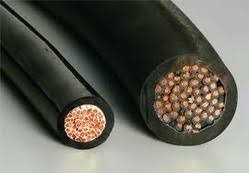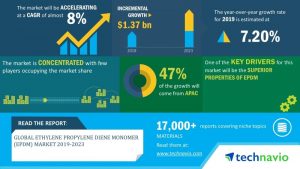Ethylene-Propylene Rubbers are valuable for their excellent resistance to heat, oxidation, ozone and weather aging due to their stable, saturated polymer backbone structure. Properly pigmented black and non-black compounds are color stable.
As non-polar elastomers, they have good electrical resistivity, as well as resistance to polar solvents, such as water, acids, alkalis, phosphate esters and many ketones and alcohols.
Related Project: Ethylene Propylene Rubber - Manufacturing Plant, Detailed Project Report, Profile, Business Plan, Industry Trends, Market Research, Survey, Manufacturing Process, Machinery, Raw Materials, Feasibility Study, Investment Opportunities, Cost And Revenue

Amorphous or low crystalline grades have excellent low temperature flexibility with glass transition points of about minus 60 °C.
Heat aging resistance up to 130°C can be obtained with properly selected sulfur acceleration systems and heat resistance at 160°C can be obtained with peroxide cured compounds. Compression set resistance is good, particularly at high temperatures, if sulfur donor or peroxide cure systems are used.
These polymers respond well to high filler and plasticizer loading, providing economical compounds. They can develop high tensile and tear properties, excellent abrasion resistance, as well as improved oil swell resistance and flame retardance.
Properties of Ethylene Propylene Rubber:-
Ethylene propylene rubber (EPR, EPM) is a copolymer of ethylene and propylene. This type of elastomer is very similar to EPDM rubber, but unlike EPDM, EPR does not have any double bonds in the main chain, whereas EPDM rubbers contain small amounts of non-conjugated diene monomers which provide cross-linking sites for vulcanization. EPRs, on the other hand, can only be crosslinked with a peroxide-based cure system or by irradiation with high-energy radiation such as gamma rays or high energy electrons which generate free radicals that induce crosslinking.
Related Books:- Rubber Processing And Compounding Technology Books, Rubber Processing Chemicals And Leather Processing Technology Books
EPMs have excellent resistance to heat, oxidation, weather, and ozone. They also exhibit excellent electrical insulation, and low temperature properties, but have only fair mechanical properties. Their resistance to chemicals is generally good. For example, EPRs are resistant to many polar fluids both parotic and aprotic. This includes most phosphate-ester based hydraulic fluids, silicone oils and greases, glycol- and silicon-based based brake fluids, sodium and potassium alkalis as well as hot water and steam up to 150°C. However, EPRs have poor mineral oil and flame resistance.
The largest market for EPRs is the automotive industry. Typical applications include tires, tubes, weather strips, O-rings, gaskets, accumulator bladders, wire and cable connectors, and various automotive parts.
Trends in India with Key Growth Factors:-
The global ethylene propylene (EPR) market is expected to grow from $7.62 billion in 2020 to $9.52 billion in 2021 at a compound annual growth rate (CAGR) of 24.9%.The growth is mainly due to the companies rearranging their operations and recovering from the COVID-19 impact, which had earlier led to restrictive containment measures involving social distancing, remote working, and the closure of commercial activities that resulted in operational challenges. The market is expected to reach $11.9 billion in 2025 at a CAGR of 6%.
Related Videos:- Rubber and Rubber Products, Rubber based Industries, Natural Rubber, Synthetic Rubber, Rubber Chemicals, Extruded Rubber, Adhesives & Sealants

Use of ethylene propylene across various industries contributes to the growth of the ethylene propylene market. In the automotive industry, EPR products bonds well with metals by providing a well-built barrier against the environment. EPR possesses properties such as heat resistance, abrasion resistance, oil swell resistance, flame retardance, oxidation, ozone and weather aging due to their stable, saturated polymer backbone structure. Companies such as BRP manufacturing is providing EPR for automotive industries that include under-the-hood, cabin pressure equalizing assemblies, interior trim, and striker plate blinds. Thus, the usage of EPR in different industries is contributing to the EPR market growth.
Conclusion:
The project report from NPCS named “Ethylene Propylene” the market research report gives you a clear picture of the industry. The report also provides the forecasted trends and growth to give an idea of forecasted market tendency. The forecasted data is provided after secondary research and are also cross-validated through the interaction with the industry players. All the data provided in the report is taken from reliable sources.
Noo_Art2021
#DetailedProjectReport #businessconsultant #BusinessPlan #feasibilityReport #NPCS #industrialproject #entrepreneurindia #startupbusiness #BusinessIdeas #StartupBusinessIdeas #BusinessOpportunity #Ethylenepropylenerubber #RubberBusiness #RubberIndustry #RubberProducts